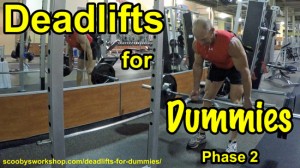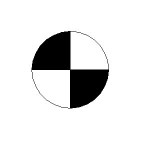Deadlifts For Dummies
Why listen to me?
Why on earth should you listen to me about deadlifts? I have never won a powerlifting competition. My legs are under developed when compared to my upper body (Does Scooby do legs?). Why not take the advice of experts like Jonnie Candito? Great question! If you are young, coordinated, and have no joint problems then you don’t need my advice. Head on over to Jonnie Candito’s YouTube videos, he is a good guy and knows his stuff. On the other hand, if you are older, a bit un-coordinated, or have knee or lower back issues then a slower approach like I suggest here is called for. If I can safely start deadlifting in my 50’s with my chronic lower back issues and knee issues then there is a good chance I can show you how to as well!
You see a lot of bad form in the gym when it comes to deadlifts and the Crossfit folks have made it worse. So many these days just seem to “grab and yank” which might work for an 18 year old but its suicide for anyone above 30. I’m old, and like a lot of older people I have a number of joint issues – lower back being one of them. When starting deadlifts, I needed to use a very careful progression to avoid injury. If I can deadlift, anybody can. If I can safely start deadlifting in my 50’s with my chronic lower back issues and knee issues then there is a good chance I can show you how to as well. Remember, you don’t have to lift a lot of weight.
Why Deadlift?
Good question. If its such a “dangerous” exercise, why do it? First of all, its only dangerous when done with too much weight or with bad form. If you were injured deadlifting, it was one of those two things – period. Leaving out the “posterior chain” mumbo jumbo, here are the big advantages of the deadlift in my view:
- Its simple and can be done safely with simple equipment at home – no power rack needed
- Its a compound exercise working several major muscle groups in the body at once which makes it ideal for time efficient strength training workouts
- Because it uses so many large muscles in the body, its an ideal exercise to be used in indoor or home HIIT cardio workouts (see complexes)
- In my experience, babying the lower back doesn’t make lower back pain better, it makes it worse. If you let your spinal extensors turn to mush by inactivity you are just asking for lower back injuries and back pain. What seems to help lower back pain prevention for me is increasing my spinal extensor static strength, that is being able to hold my torso in a nearly horizontal position while waited for long durations, as in, over 30 seconds. All versions of deadlifts help improve spinal extensor strength and endurance. [NOTE: I am NOT a medical professional and this is simply my opinion]
I don’t worship deadlifts nor do I think they are magical. Big compounds like deadlifts and squats have their use and isolation exercises and machines also have their uses. An optimal plan for most people will require both. The reason that so many people get injured doing them is that they ego-lift heavy weights before they have the form nailed. Having said that, don’t be a dummy. If you have back issues, make sure to discuss deadlifting with your doctor or physical therapist (physiotherapist) before starting even an easy simple progression like I suggest below!
Deadlifts For Dummies, Phase 1
Phase 1 of Deadlifts for Dummies is 3 months of spinal extensor strengthening, neutral back position work, and CG control which will provide a foundation for safe deadlifting. The usual reason that people hurt themselves deadlifting is that they lift too much weight before they have nailed the form or before their spinal extensors are strong enough to deal with the loads. Most people’s spinal extensors are mush which is why lower back pain is the #1 cause of people calling in sick to work. Strong spinal extensors not only support your back and help prevent lower back injury but they are critical to being able to hold the neutral position under heavy loads and deadlift safely.
Now the jocks out there are screaming, “just do deadlifts!” to strengthen your spinal extensors. Yes, deadlifts do strengthen your spinal extensors but its really risky, one mistake and you are toast … and beginners to deadlifting make lots of mistakes. This is exactly why deadlifting has such a bad reputation for being a dangerous exercise!
Lets talk about engineering concept of “error margin”. A Cessna 150 and a F-35 both fly but the error margin is completely different. A Cessna 150 literally is so slow and stable that it can fly itself, its really, really hard to crash a Cessna 150. On the other hand, a F-35 is a high performance fighter where you are literally one sneeze away from a crash. The difference is the margin for error. The Cessna 150 is much more forgiving which is why student pilots fly 150s and not F-35s. Same with deadlifts. The SDL is the Cessna 150, the deadlift is the F-35. You are much more likely to crash and burn if you jump right into the F-35 without spending enough time learning in the Cessna 150.
Here is the phase 1 of the Deadlifts for Dummies program, you just tack these exercises onto your existing lat and leg workouts during the next 3 months:
1) SDL 4 sets of 12-16reps
2) Bent over barbell rows for lats, 4 sets of 12-16reps
3) CG balance dumbbell deadlifts, 1 set of 9
Lets start with the SDL because that is by far the most important. By SDL I do NOT mean the stiff legged deadlift, I mean the SCOOBY deadlift. The reason is the nobody can seem to agree what the stiff legged deadlift is and people LOVE arguing about it so I made up my own exercise. The SCOOBY deadlift, as I define it, which I can, because I AM SCOOBEEEE, is done with straight but not locked knees that remain motionless. Its a bend at the hip with the back held perfectly in the neutral position. Go as low as you can, then back up. Please watch the video in the upper right hand corner if you need additional help with this exercise. I want you do do 4 sets of 12-16 reps on your leg day. Start really light and only slowly increase your weights as you are sure you can maintain perfect form. Do very slow and controlled reps focusing on keeping your back in the neutral position.
Second exercise I want you to do in this 3 month prep period is the bent over barbell row for lats is done with straight but not locked knees, back in the neutral position, row to the hip. If you are confused, watch the video in the upper right hand corner. This exercise is hitting lats but more importantly its helping build up your spinal extensors. Do 4 sets of 12-16 on your lat workout day. Do your reps slowly. The whole point of this exercise is to build up the muscular endurance of your spinal extensors. If you crank thru your 16 reps in 8 seconds it completely defeats the purpose. Try to make those 16 reps last 30 seconds. Best is if you set a countdown timer on your smart phone and set it on the floor where you can see the display. When lifting, people always do reps way faster than they think they are, please don’t rely on your internal clock here but rather use a timer or clock.
The third exercise I want you to do on leg day is one set of 9 reps doing a very light dumbbell deadlift. The purpose of this exercise is to work on your center of gravity control, or as us engineers always abbreviate CG control. The symbol at the right will be familiar to those in physics and engineering. Its the center of gravity symbol. It means that if your entire body can be represented by your weight at this exact position
The other skill you need before you can do squats and deadlifts is the ability to feel where your center of gravity is balancing on your feet. The reason this is so important is that both in deadlifts and squats, your knee and hip angles are critical but you cant see them unless you look sideways in a mirror and glancing to the side would be suicide with any reasonable amount of weight. There is another way to sense where your hips and knees are without looking, its your CG. Where you let your CG act on your feet geometrically confines how you can bend down. If you control your CG, your form will be very close to being correct.
Try this experiment so you see what I mean. Lift your heels off the ground and stand on your toes. Now squat down and touch the ground while keeping your feet in that position – what happens? The only way you can squat down is by scissoring your knees forward. This is BAD form for any leg exercise. If you feel your weight on the balls of your feet like this when you are squatting or deadlifting then STOP, you are about to die.
Now lets to another experiment. Lift your toes off the ground, put all your weight on your heels and repeat the experiment – squat down and touch the ground any way you can. The only way you can do it is by moving your hips back and sitting down. This is good form for most leg exercises but its too extreme because we don’t want to fall over backwards. Falling over backwards is never good when holding half a ton of iron.
Where your center of gravity is over your feet drastically limits your hip and knee geometry. To be able to squat and deadlift properly you have to have your CG in the right range or you wont physically be able to do them properly. There is no way in the world you can possibly squat or deadlift properly on the balls of your feet because you wont be able to get your hips back far enough.
Here is a great little exercise to work on developing a feel for your center of gravity. Get some dumbbells, should not be heavy, under 50 pounds. In this exercise we are going to do dumbbell deadlifts while comparing the pressure on our heel to the pressure on the ball of our foot.
- On rep 1 we will try to keep a little more pressure on the the heel than the ball.
- On rep 2 we will try to keep a little more pressure on the ball than the heel.
- On rep 3 we will try to keep equal pressure on both.
- Repeat till you have done 9 reps
Just do one set of this exercise on your leg day, thats it. Just one set a week to make your brain think about where the weight is on your feet. When you have mastered that, do it with your eyes closed. Fortunately the pressure sensors on our feet are incredibly accurate, its the reason we can balance on one foot. All you have to do is to focus on it and you will feel it. Its like so many things in our bodies, once you listen to them you will hear them.
Deadlifts for Dummies, Phase 2
The baby deadlift. This is not a real deadlift because its not a fluid motion and the mechanics are different but its easy to master with safe form. With phase 2 we are training our bodies to do to separate movements, the lower half of the deadlift and the upper half of the deadlift. We want to burn into our neurons what happens on each end of the movement so we don’t ever get confused. In phase 3 we will learn to connect them in a smooth fashion. Its easy to think of one thing at a time and thats what this exercise is, just one simple thing at a time:
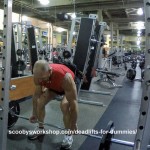 |
Grab the bar on the ground with neutral back and using the quads only, straighten the legs (with the back angle unchanging). |
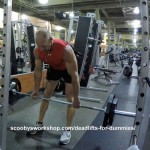 |
After your legs are straight, pause in this position. Notice what position we are in? Yep, its the ending position of the SDL! Now its time to give the quads a rest and use the hamstrings and lower back. We now keep the legs immobile and rotate at the hip upward till we are standing upright. Make sure to exaggerate and lean back slightly in the up position. Yes, you just did a SDL! |
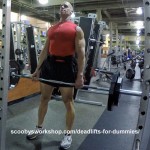 |
Now we are up and leaning back slightly. With the legs immobile, bend forward at the hip – in other words do a SDL. |
 |
After you have bent forward into this position, you have done your SDL – pause here for a moment. |
 |
Now hold your torso and lower back motionless, bend at the knees to lower the bar back to the ground and the starting position. |
Easy peasy lemon squeezy!
So why are we bothering with this? Great question! Jocks and naturally athletic people just don’t understand this but us uncoordinated folk can have trouble with even simple movements. Seriously, I even have trouble with waltz and two-stepping which are two of the easiest dances around. We can learn complex motions but it takes us longer. It took me 25 years of playing beach doubles volleyball to get to B level when I have seen naturally athletic people do it in a single year. Us uncoordinated folk CAN learn but it takes longer to train our neurons and muscle memory.
The deadlift is actually a simple movement but if you forget even for an instant what you should be doing, its all over – somebody is calling 9-1-1 for you. You see this all the time at the gym, someone lifting to much weight stalls so they round their back like an arching cat to try to DRAG the bar up. So anyway, THATS why we are bothering. We want to hardwire our brain so that when we get into sticky situations we don’t need to think, our muscles know what to do.
Note about the knees and feet. In this baby deadlift we use a normal stance not a sumo stance so we stand naturally. Feet point very slightly out. There is a tendency to want to let the knees pop out to the sides as you go down, don’t let them. While we are on the subject, real powerlifters use a double overhand grip. Guess what? I DONT CARE what they use, I use an opposing grip because its easier on my old tendons. Use whatever you want.
Safety rule #1: You may not use more weight than you can SDL with in phase 1! Why? If you use more weight than that you will not be able to use the simple and safe form I am discussing here. If you want to do more weight here with the baby deadlift then continue with phase 1 in parallel to increase your SDL weight.
So phase 2 looks a little like a deadlift but its simple because its the coupling of two very simple motions – you really cant screw up! If you can SDL then you can do this! When you are doing these, don’t concern yourself with making it a fluid motion – keep it in two parts in your brain: Now I am doing a SDL, now I am bending my knees – you will never be doing both at the same time. If you are, you are not doing phase 2 correctly. Stay in phase 2 for at least 2 months.
Deadlifts for Dummies, Phase 3
(under construction)

